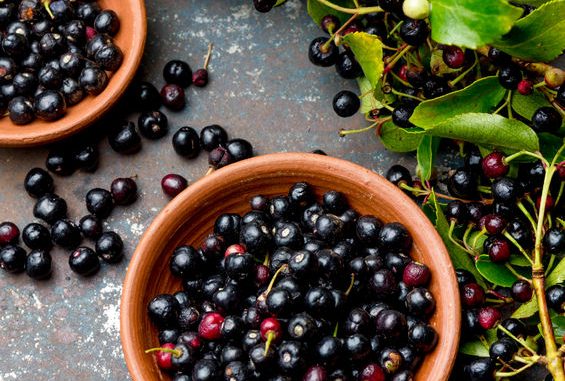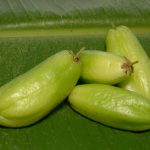
If you were looking for a strong purple coloured berry fruit then the Maqui (Aristotelia chilensis (Molina) Stuntz) might just answer your requests. It comes from central and southern Chile, and Argentina and is usually consumed raw as a berry or as juice. It is now possible to find it as a freeze-dried powder for use in beverage mixes. I’ve seen it in sports products like the Motion Nutrition Post-Workout Recovery sports powder. You might also find it in capsules and liquid extracts along with beverages as part of an exotic berry mix.
Commercially, the fruit bushes are still grown in the wild although there is now an attempt to plant organised fields of bushes. The flavour is reminiscent of blackberries and is sometimes called the Chilean Blackberry as well as the Chilean Wineberry because of the similarity.
Componentry.
The health benefits are numerous and in keeping with many fruits labelled as superfruits. It contains amongst other components, anthocyanins, flavonoids and phenols. That makes it identifiable with fruit such as amla from India. All these components have potent anti-inflammatory benefits as well as highly beneficial antioxidant effects (Cespedes et al., 2008; 2009).
The anthocyanins have been examined (Escribano-Bailon et al., 2006). Th fruit also contains plenty of glucosies and sambubiosides. These compounds have been demonstrated to inhibit the sodium-glucose cotransporter type 1 (SGLT1) in the rat duodenum.
The principal phenolics are gallic acid, protocatecuic acid, catechin, rutin, ellagic acid, dimethoxy-quercetin,
p-coumaric acid, trans-ferulic acid, myricetin, and quercetin (Galvez et al., 2016). These have been identified using HPLC/MS/MS .
The antioxidant content is very high – it has an extremely high ORAC antioxidant capacity.
Traditionally, the fruit was used in Chilean medicine for reducing the ill effects of diarrhea (Hoffman, 1991).
Benefits Of Maqui For Managing Diabetes
A few studies have demonstrated anti-diabetic benefits. Researchers at Rutgers University and North Carolina State University found that a standardized formulation containing the colour pigments, the anthocyanins, from maqui berry might improve glucose tolerance in in hyperglycemic and obese mice. These mice were fed a high fat diet which meant their ability to ‘deal’ with elevated blood glucose levels was compromised. The results showed that there was a marked improvement to insulin mediated and non-insulin mediated glucose uptake in insulin-sensitive muscle cells.
Human studies are much more important if the health benefits are to be proven clinically. Here, a small study reported in BioMed Research International showed that subjects with a disposition to diabetes and called prediabteics could be given a single dose of a standard anthocyanin rich extract of maqui. It lowered their insulin levels and fasting blood glucose levels (Alvarado et al., 2016) when they were challenged by drinking glucose. The extract contains delphinidin which are the bluest of the anthocyanins and comes in a product called Delphinol.
Delphinol is a proprietary maqui berry extract with a standardized content of 25% w/w delphinidin glycosides and 35% total anthocyanins. It can significantly inhibit postprandial blood glucose 60 and 90 minutes after boiled rice intake, with a single 200 mg dose before food consumption (Hidalgo et al., 2014). A great deal of research is now being conducted on Delphinol to understand just how potent this extract is (Davinelli et al., 2015; Watson and Schönlau, 2015).
The fruit may well have similar benefits to blackcurrants and aronia.
References
Alvarado, J.L., Leschot, A., Olivera-Nappa, Á., et al. (2016) Delphinidin-Rich Maqui Berry Extract (Delphinol®) Lowers Fasting and Postprandial Glycemia and Insulinemia in Prediabetic Individuals during Oral Glucose Tolerance Tests. BioMed Research International. 2016:9070537. doi:10.1155/2016/9070537. https://www.ncbi.nlm.nih.gov/pmc/articles/PMC5153493/
Cespedes, C., El-Hafidi, M., Pavon, N., J. A. (2008) Antioxidant and cardioprotective activities of pheniloic extracts from fruits of Chilean blackberry Aristotelia chilenesis (Elaeocarpaceae), Maqui. Food Chemistry. 108 pp. 820–829
Cespedes CL, Alarcon J, Valdez-Morales M, Paredes-Lopez O. (2009) Antioxidant activity of an unusual 3-hydroxyindole derivative isolated from fruits of Aristotelia chilensis (Molina) Stuntz. Z Naturforsch C. 64(9–10) pp.759–762 https://www.ncbi.nlm.nih.gov/pubmed/19957448
Davinelli S. I., Bertoglio J. C., Zarrelli A., Pina R., Scapagnini G. (2015) A randomized clinical trial evaluating the efficacy of an anthocyanin-maqui berry extract (DelphinolⓇ) on oxidative stress biomarkers. Journal of the American College of Nutrition. 34(34, supplement 1) pp. 28–33.
Escribano-Bailon MT, Alcalde-Eon C, Munoz O, Rivas-Gonzalo JC, Santos-Buelga C. (2006) Anthocyanins in berries of Maqui (Aristotelia chilensis (Mol.) Stuntz). Phytochem. Anal. 17(1) pp. 8–14
Galvez, A.V., Poblete, J., Aranda, M., Delgadillo, A. (2016) Retention of Bioactive Compounds and Antioxidant Capacity of Maqui Berry (Aristotelia Chilensis [Mol]Stuntz) as Influenced by Drying Methods. IFT16 Abstracts P04-094 Book of Abstracts
Hidalgo J., Flores C., Hidalgo M. A., et al. (2014) Delphinol® standardized maqui berry extract reduces postprandial blood glucose increase in individuals with impaired glucose regulation by novel mechanism of sodium glucose cotransporter inhibition. Panminerva Medica. 56(supplement 3) pp. 1–7 https://www.ncbi.nlm.nih.gov/pubmed/24861886
Hoffman, A. (1991) Flora silvestre de Chile zona araucana. Santiago: Fundacion Claudio Gay.
Miranda-Rottmann, S., Aspillaga, A.A., Perez, D.D., Vasquez, L., Martinez, A.L., Leighton, F. (2002) Juice and phenolic fractions of the berry Aristotelia chilensis inhibit LDL oxidation in vitro and protect human endothelial cells against oxidative stress. J. Agric. Food Chem. 50(26) pp. 7542–7547
Rojo, L.E., Ribnicky, D., Logendra, S., et al. (2012) In Vitro and in Vivo Anti-Diabetic Effects of Anthocyanins from Maqui Berry (Aristotelia chilensis). Food Chemistry. 131(2) pp. 387-396. doi:10.1016/j.foodchem.2011.08.066.
Watson R. R., Schönlau F. (2015) Nutraceutical and antioxidant effects of a delphinidin-rich maqui berry extract Delphinol®: a review. Panminerva Medica. 63(2), supplement 1 pp. 1–12.


Leave a Reply